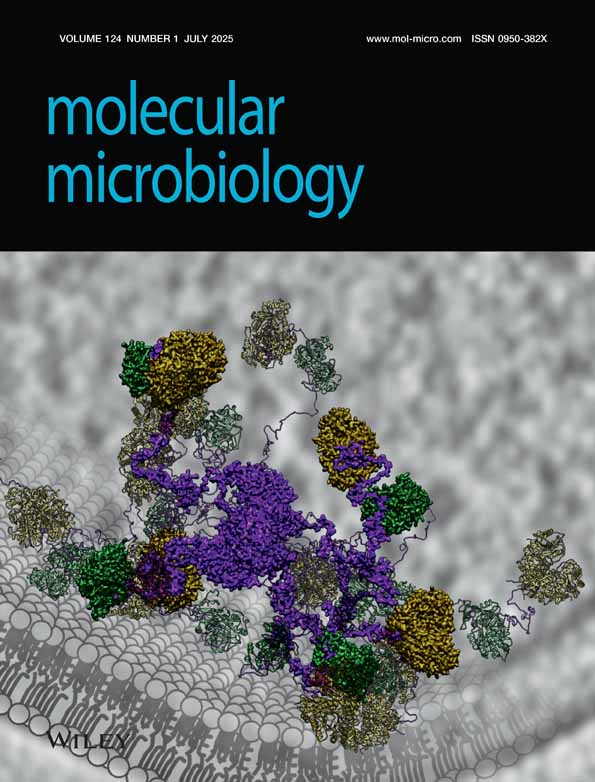Inducible DNA repair and differentiation in Bacillus subtilis: interactions between global regulons
Corresponding Author
Ronald E. Yasbin
Department of Biological Sciences and the Program in Molecular and Cell Biology, UMBC, 5401 Wilkens Avenue, Baltimore, Maryland 21228-5398, USA.
*For correspondence. Tel. (410) 455 3668; Fax (410) 455 3837.Search for more papers by this authorDavid L. Cheo
Department of Biological Sciences and the Program in Molecular and Cell Biology, UMBC, 5401 Wilkens Avenue, Baltimore, Maryland 21228-5398, USA.
Search for more papers by this authorKen W. Bayles
Department of Biological Sciences and the Program in Molecular and Cell Biology, UMBC, 5401 Wilkens Avenue, Baltimore, Maryland 21228-5398, USA.
Search for more papers by this authorCorresponding Author
Ronald E. Yasbin
Department of Biological Sciences and the Program in Molecular and Cell Biology, UMBC, 5401 Wilkens Avenue, Baltimore, Maryland 21228-5398, USA.
*For correspondence. Tel. (410) 455 3668; Fax (410) 455 3837.Search for more papers by this authorDavid L. Cheo
Department of Biological Sciences and the Program in Molecular and Cell Biology, UMBC, 5401 Wilkens Avenue, Baltimore, Maryland 21228-5398, USA.
Search for more papers by this authorKen W. Bayles
Department of Biological Sciences and the Program in Molecular and Cell Biology, UMBC, 5401 Wilkens Avenue, Baltimore, Maryland 21228-5398, USA.
Search for more papers by this authorSummary
The SOS response of Escherichia coli has become a paradigm for the study of inducible DNA repair and recombination processes in many different organisms. While these studies have demonstrated that the components of the SOS response appear to be highly conserved among bacterial species, as with most models, there are some significant variations. Perhaps the best example of this comes from an analysis of the SOS-like system of the developmental organism. Bacillus subtilis. Accordingly, the most striking difference is the complex developmental regulation of the SOS system as this organism differentiates into its competent state. In this review we have given an overview of the elements that comprise the SOS system of B. subtilis. Additionally, we have summarized our most recent findings regarding the regulation of this regulon. Using these results along with new findings from other laboratories we have provided provocative molecular models for the regulation of the B. subtilis SOS system in response to DNA damage and during competent cell formation.
References
- Bailone, A. et al. (1991) Biochimie 73: 471–478.
- Cheo, D.L. et al. (1991) J Bacteriol 173: 1696–1703.
- Cheo, D.L. et al. (1992) Molecular characterization of regulatory elements controlling expression of the Bacillus subtilis recA+ gene. Biochimie, in press.
- Campbell, L.A., and Yasbin, R.E. (1984) J Bacteriol 160: 288–293.
- Dhaese, P. et al. (1985) Nucl Acids Res 13: 5441–5455.
- Dubnau D. (1991) Microbiol Revs 55: 395–424.
- Fields, P.I., and Yasbin, R.E. (1980) J Bacteriol 144: 473–475.
- Fields, P.L, and Yasbin, R.E. (1983) Mol Gen Genet 190: 465–480.
- Giliespie, K., and Yasbin, R.E. (1987) J Bacteriol 169: 3372–3374.
- Gralla, J.D. (1989) Cell 57: 193–195.
- Hadden, C., and Nester, E.W. (1968) J Bacteriol 95: 876–885.
- Hanawalt, P.C. (1989) Environ Mol Mutagenesis 14 (Suppl. 16): 90–98.
- Harris, W.J., and Barr, G.C. (1971) Mol Gen Genet 113: 331–344.
- Lesca, C. et al. (1991) Biochimie 73: 399–406.
- Little, J.W. (1991) Biochimie 73: 411–422.
- Lobell, R.B., and Schleif, R.F. (1990) Science 250: 528–532.
- Love, P.E., and Yasbin, R.E. (1984) J Bacteriol 160: 910–920.
- Love, P.E., and Yasbin, R.E. (1986) Proc Natl Acad Set USA 83: 5204–5208.
- Love, P.E. et al. (1985) Proc Natl Acad Sci USA 82: 6201–6205.
- Lovett Jr, CM., and Roberts, J.W. (1985) J Bid Chem 260: 3305–3313.
- Lovett Jr, C.M. et al. (1989) J Bacteriol 171: 2318–2322.
- Marrero, R., and Yasbin, R.E. (1988) J Bacteriol 170: 335–344.
- Mohan, S., and Dubnau, D. (1990) J Bacteriol 172: 4064–4071.
- Msadek, T. et al. (1991) J Bacteriol 173: 2366–2377.
- Nohmi, T. et at. (1988) Proc Natl Acad Sci USA 65: 1816–1820.
- Noyer-Weidner, M. et al. (1983) J Virol 46: 446–453.
- Radman, M. (1974) In Molecular and Environmental Aspects of Mutagenesis. S. Prakash et al. (eds). Springfield , IL : CC. Thomas, pp. 128–142.
- Raymond-Denise, A., and Guillen, N. (1991) J Bacteriol 173: 7084–7091.
- Rudner, R. (1981) Mutat Res 83: 321–327.
- Sicard, N. (1983) J Bacteriol 154: 995–997.
- Stranathan, M.C. et al. (1990) Nucl Acids Res 18: 4249.
- Walker, G.C. (1984) Microbiol Rev 48: 60–93.
- Witkin, E.M. (1976) Bacteriol Rev 40: 869–907.
- Witkin, E.M. (1991) Biochimie 73: 133–142.
- Wood, H.E. et al. (1990) Gene 96: 83–88.
- Wojciechowski, M.F. et al. (1991) J Bacteriol 173: 6489–6498.
- Yasbin, R.E. (1977a) Mol Gen Genet 153: 211–218.
- Yasbin, R.E. (1977b) Mol Gen Genet 153: 219–225.
- Yasbin, R.E. et al. (1975) J Bacteriol 137: 391–396.
- Yasbin, R.E. et al. (1980) Gene 12: 155–157.
- Yasbin, R.E. et al. (1987) In Genetics of Industrial Microorganisms. M. Alacevic et al., (eds), pp. 73–84.
- Yasbin, R.E. et al. (1988) In Genetics and Biotechnology of Bacilli, Vol. I. A.T. Ganesan, and J.A. Hoch (eds). New York . Academic Press, pp. 110–113.
-
Yasbin, R.E.
et al. (1990) In
Genetics and Biotechnology of the Bacilli, Vol. 3. M.M. Zukowski
et al. (eds).
New York
,
NY
: Academic Press, pp.
131–140.
10.1016/B978-0-12-274162-3.50018-9 Google Scholar
- Yasbin, R.E. et al. (1991a) Biochimie 73: 245–250.
- Yasbin, R.E. et al. (1991b) Res Microbiol 142: 885–892.
- Youngman, P.J. et al. (1985) In Molecular Biology of Microbial Differentiation. J.A. Hoch, and P. Setlow (eds). Washington , DC : American Society for Microbiology, pp. 44–54.




